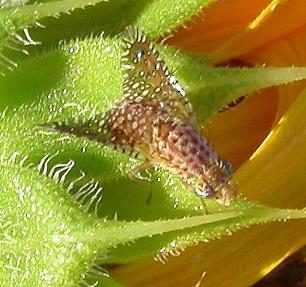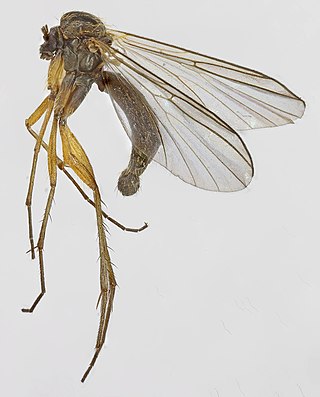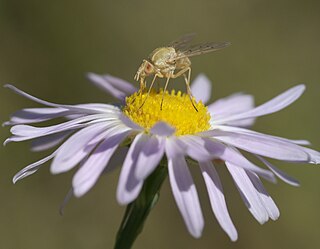
The Bombyliidae are a family of flies, commonly known as bee flies. Adults generally feed on nectar and pollen, some being important pollinators. Larvae are mostly parasitoids of other insects.
Glowworm or glow-worm is the common name for various groups of insect larvae and adult larviform females that glow through bioluminescence. They include the European common glow-worm and other members of the Lampyridae, but bioluminescence also occurs in the families Elateridae, Phengodidae and Rhagophthalmidae among beetles; as well as members of the genera Arachnocampa, Keroplatus and Orfelia among keroplatid fungus gnats.

The Drosophilidae are a diverse, cosmopolitan family of flies, which includes species called fruit flies, although they are more accurately referred to as vinegar or pomace flies. Another distantly related family of flies, Tephritidae, are true fruit flies because they are frugivorous, and include apple maggot flies and many pests. The best known species of the Drosophilidae is Drosophila melanogaster, within the genus Drosophila, also called the "fruit fly." Drosophila melanogaster is used extensively for studies concerning genetics, development, physiology, ecology and behaviour. Many fundamental biological mechanisms were discovered first in D. melanogaster. The fruit fly is mostly composed of post-mitotic cells, has a very short lifespan, and shows gradual aging. As in other species, temperature influences the life history of the animal. Several genes have been identified that can be manipulated to extend the lifespan of these insects. Additionally, Drosophila subobscura, also within the genus Drosophila, has been reputed as a model organism for evolutionary-biological studies, along with D. sechellia for the evolution of host specialization on the toxic noni fruit and Scaptomyza flava for the evolution of herbivory and specialist on toxic mustard leaves.

Keroplatidae is a family of small flies known as fungus gnats. About 950 species are described, but the true number of species is undoubtedly much higher. The long-beaked fungus gnats, formerly placed in a separate family Lygistorrhinidae, have been placed into Keroplatidae as subfamily Lygistorrhininae. They are generally forest dwellers found in the damp habitats favoured by their host fungi. They can also often be found in caves. Larvae both feed on fungi and are predatory - they can spin webs by secreting acid fluids, which they use to kill smaller invertebrates and capture spores. Some of the predatory larvae cannibalize pupa of their own species. The family notably includes three genera containing bioluminescent larvae.

Paracantha is a genus of fruit flies in the family Tephritidae.

Sciaroidea is a superfamily in the infraorder Bibionomorpha. There are about 16 families and more than 15,000 described species in Sciaroidea. Most of its constituent families are various gnats.

Symphoromyia is a genus of predatory snipe flies. Unusually for Rhagionids, some species of Symphoromyia are known to feed on mammal blood, including human blood. Symphoromyia species are stout bodied flies from 4.5 to 9 mm and with a black, grey or gold thorax, and the abdomen is coloured grey, black, or both black and yellow, black terminating with yellow, to completely yellow. The wings are hyaline or lightly infuscate.

Chaetostomella is a genus of fruit flies in the family Tephritidae.

Ectecephala is a genus of grass flies in the family Chloropidae. There are about 6 described species in Ectecephala.

The genus Zaprionus belongs to the family fruit fly Drosophilidae and is positioned within the paraphyletic genus Drosophila. All species are easily recognized by the white longitudinal stripes across the head and thorax. The genus is subdivided in two subgenera, based on the presence of an even or odd number of white stripes. The species of the genus can be found in Africa and Southern Asia. One species, Zaprionus indianus, has invaded the New World.

Eutreta is a genus of the family Tephritidae, better known as fruit flies.

Boletina is a genus of fungus gnats in the family Mycetophilidae. There are at least 30 described species in Boletina.

Coelotanypus is a genus of midges in the family Chironomidae. There are about 5 described species in Coelotanypus.

Thyridanthrax is a genus of bee flies in the family Bombyliidae. There are about 12 described species in the genus Thyridanthrax.
Keroplatus militaris is a species of predatory fungus gnats in the family Keroplatidae.

Lygistorrhininae, commonly called long-beaked fungus gnats is a subfamily of flies in the Diptera family Keroplatidae.
Heteropterna is a genus of predatory fungus gnats in the family Keroplatidae. There are at least 20 described species in Heteropterna.

Lordotus is a genus of bee flies. There are at least 30 described species in Lordotus.

Poecilognathus is a genus of bee flies. There are at least 20 described species in Poecilognathus.
Rocetelion is a genus of flies belonging to the family Keroplatidae.














